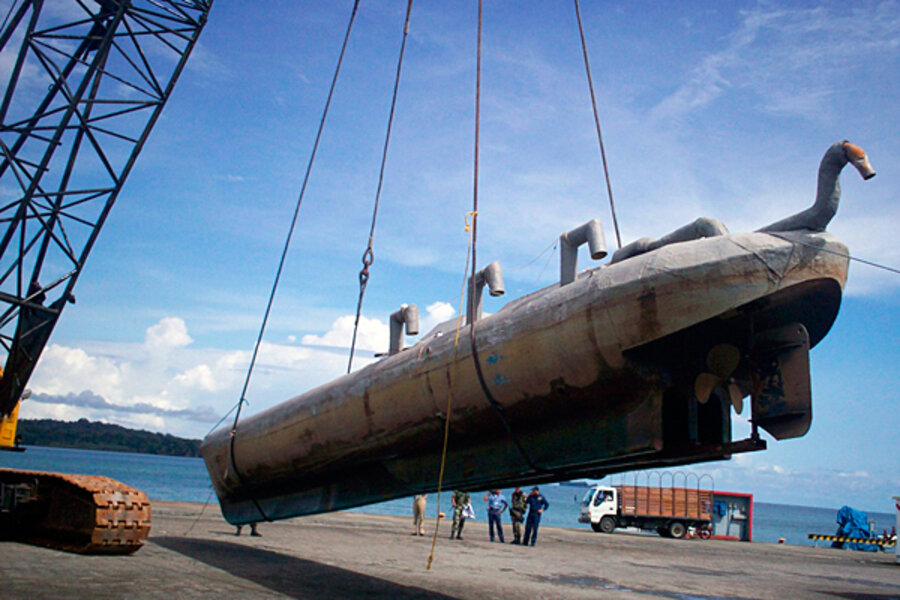Colombia's narco-sub 'museum' gives a peek into drug trafficking tactics
Loading...
| BAHIA MALAGA, Colombia
Stacked along one edge of the Bahía Málaga naval base is what authorities call “the museum” – a long row of impounded vehicles that chart the evolution of the drug trafficking industry. There are the lumbering fishing boats that used to run marijuana in the 1970s and 1980s, Miami Vice-era “go-fast” boats, and an entire fleet of manned and unmanned semisubmersibles.
But the crown jewel of the display, and the stuff of drug enforcement nightmares, is a fully functional narco-sub. Built in the jungle, the hulking blue submarine can carry eight tons of cocaine and is similar to the nation’s own tactical sub, with one addition: This one has indoor plumbing. Discovered last year in the dense mangroves that make this region a smugglers’ paradise, the submarine — technically a “snorkel sub” — can hit speeds of 12-15 knots and travel 8,000 miles. That’s more than enough to make it to the coast of California and back, said Capt. Nelson Hernandez. Designed to travel 32 feet below water with only a small intake valve protruding, it would have been virtually undetectable if it were launched, he said.
“With this kind of technology we might see a huge flow of drugs, or guns or anything heading north,” Hernandez said.
As the United States wages the war on drugs, this stretch of Colombia’s Pacific coast is the Silicon Valley of narco-innovation. When the trafficking industry develops new maritime technology to stay ahead of the law, this is often where it appears first.
RELATED: Think you know Latin America? Take our geography quiz!
For years, smugglers have been using semi-submersibles, which glide just below the water’s surface leaving no wake and a weak radar signature. Authorities began busting them in the late 1990s, but a local port manager in nearby Buenaventura recalls seeing the first one in the 1980s.
But full-fledged submarines are relatively new. Only three have been found in South America in recent years — two in Colombia and one in neighboring Ecuador. A fourth, much earlier, version was discovered in Colombia’s capital in 2000.
In Senate testimony last year, the U.S. Drug Enforcement Agency’s Chief of Intelligence Rodney Benson said the advent of “self-propelled fully submersible vessels… underscores the incredible lengths drug traffickers will take to move their product.”
“Although these vessels are unlikely to supplant more traditional drug trafficking conveyances, analysis suggests that fully submersible vehicles carry large loads of cocaine and are extremely difficult to detect,” he said.
About 60 percent of Colombia’s submersible busts relied on intelligence sources and investigative work — not technology like radar, Hernandez said.
Authorities monitor charter flights into the region and track new moons and high tides to try to predict traffickers’ moves. Smugglers are superstitious, so authorities keep tabs on the local brujas, or witches, for clues, he said.
“When does the bruja bring in her herbs? When is the bruja alone? When is the bruja at home? When does the bruja have guests?” Hernandez said. “All of these things are part of the analysis.”
Authorities have impounded 23 semisubmersibles and detected 96 over the years. Countless others have been scuttled by traffickers to keep from being caught, Hernandez said.
For the vessels that make it away from the Colombian shores, an intelligence center in Key West, run by the U.S. Southern Command, guides Coast Guard and DEA agents to suspect boats in collaboration with Central American law enforcement.
Colombia has dramatically cut down its coca-leaf and cocaine production over the last decade, but it remains the largest supplier of the narcotic to the United States. This year along Colombia’s Pacific, more than 80 tons of cocaine has been seized, the Navy said.
While the submarine may be the most dramatic innovation, it’s not the only one.
Tucked between the vessels at the “museum” are what look like steel torpedoes — or what officials here call “unmanned submersibles.”
The torpedoes are streamlined containers that can carry several tons of cocaine and be towed behind an inconspicuous fishing vessel or attached to the hull of a boat. If the traffickers suspect they are about to be raided, they simply cut it loose.
“About a month ago, we noticed that they were starting to use electronic beacons on the unmanned submersibles,” Hernandez said. The technology allows smugglers to ditch their cargo and recover it days or weeks later.
Another recent innovation is the use of drop boxes that can be packed with cocaine and buried on a beach in, say, Costa Rica or Nicaragua.
RELATED: Think you know Latin America? Take our geography quiz!
“When the payment comes through, the client is given the coordinates of where to find the boxes,” Hernandez explained, “so there’s never a face-to-face meeting.”
As he peered into the hatch of one of the semisubmersibles, Lt. Diego Areiza described the drug war as a cat-and-mouse technology race.
“This is an example of the evolution of criminal innovation,” he said. “But it’s also an example of the way we’re evolving. Otherwise, you wouldn’t see all these vessels here.”
Capt. Ricardo Benitorevollo is a submariner in the Colombian Navy and has studied the narco-sub carefully. He said the machine has sophisticated submersion and trim controls, a ballast management system and central AC. When they discovered it, it was loaded with packages of caustic soda, suggesting the machine also was going to have an oxygen scrubber. He estimated it might cost $2 million to build.
Asked how it compared to Colombian subs, he said it was very similar to the Navy’s tactical sub but had more amenities. On the Colombian sub, officers have to go on deck to use the bathroom. The narco-sub has an interior bathroom.
There’s also another difference, he said: “Their beds are bigger.”
Miami Herald staff writer Carol Rosenberg contributed to this report from Miami.
Read more here: http://www.mcclatchydc.com/2012/12/03/176143/colombias-narco-sub-museum-gives.html#storylink=cpy







